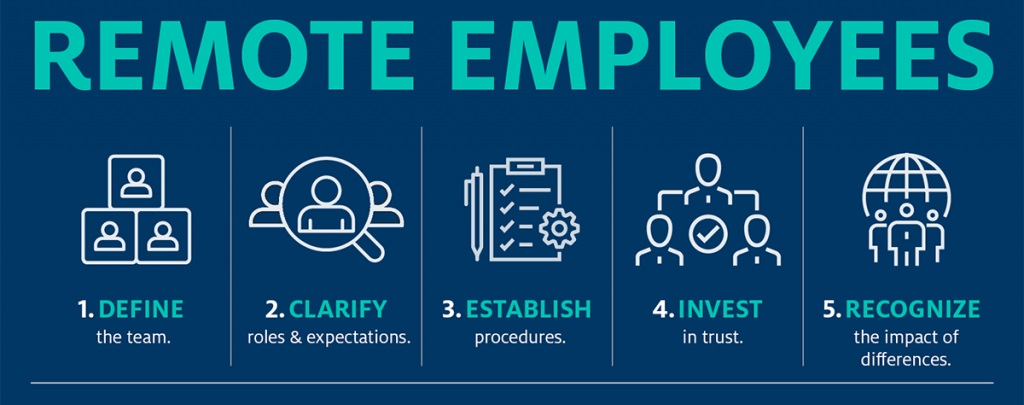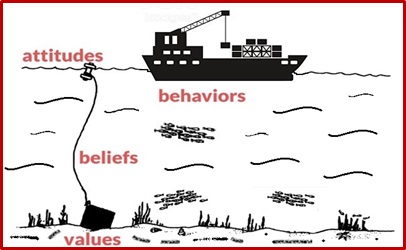
In response to the uncertainties presented by Covid-19, many companies and universities have asked their employees to work remotely. The new policies leave many employees — and their managers — separated from each other for the first time.
Common Behavioural Challenges of Remote Workforces
Managers first ought to understand factors that can make remote work especially demanding. Both managers and their employees often express concerns about the lack of face-to-face interaction. Supervisors worry that employees will not work as hard or as efficiently (though research indicates otherwise, at least for some types of jobs). Many employees, on the other hand, struggle with reduced access to managerial support and communication. Challenges inherent in remote work include:
- Lack of access to information:
Newly remote workers are often surprised by the added time and effort needed to locate information from colleagues. Even getting answers to what seem like simple questions can feel like a large obstacle to a worker based at home. This phenomenon extends beyond task-related work to interpersonal challenges that can emerge among remote colleagues.
Research has found that a lack of “mutual knowledge” among remote workers translates to a lower willingness to give colleagues the benefit of the doubt in difficult situations. For example, if you know that your officemate is having a rough day, you will view a brusque email from them as a natural product of their stress. However, if you receive this email from a remote colleague, with no understanding of their current circumstances, you are more likely to take offense, or at a minimum to think poorly of your colleague’s professionalism.
- Social Isolation and Loneliness:
Loneliness is one of the most common complaints about remote work, with employees missing the informal social interaction of an office setting. It is thought that extraverts may suffer from isolation more in the short run, particularly if they do not have opportunities to connect with others in their remote-work environment. However, over a longer period of time, isolation can cause any employee to feel less “belonging” to their organization, and can even result in increased intention to leave the company.
Not surprisingly then, it’s a huge health factor that impacts not only our psychology but even our physical health. Isolation and loneliness in humans are just as detrimental. Prolonged isolation can in extreme cases result in things like anxiety and depression.
When working remotely, we miss out on so many opportunities to connect with our colleagues and managers. More than just that, though, we also feel like our teammates don’t hear us the same. We often feel like leadership doesn’t take notice of us the way they do those working in office. A survey of remote employees found that 37% of those surveyed believe that working remotely can lead to reduced visibility and less access to company leadership.
- Distractions in the Environment:
Typically, we encourage employers to ensure that their remote workers have both dedicated workspace and adequate childcare before allowing them to work remotely. Yet, in the case of a sudden transition to virtual work, there is a much greater chance that employees will be contending with suboptimal workspaces and (due to school and daycare closures) unexpected parenting responsibilities. Even in normal circumstances family and home demands can impinge on remote work; managers should expect these distractions to be greater during this unplanned work-from-home transition.
- Communication issues due to a lack of non-verbal cues:
We lose some of those hallway conversations, and quick in-office chats, but it goes deeper than that. It can become difficult to sense intent in messages between you and your team. The philosophical concept Hanlon’s razor, coined by author Robert J. Hanlon, says that we should “assume ignorance before malice,” when communicating with others. It is based on thousands upon thousands of years of primal programming that causes us to assume something is a threat by default for the sake of survival.
The problem is, that natural defence mechanism doesn’t help us much in a modern workplace. When you’re messaging an employee, they’re liable to assume negative intent when you say something they could take as a “threat” (such as when you offer a critique, feedback, ask a question, etc.), and the same goes for you. Without any of the non-verbal cues to discern intent from what we see and hear, communication issues can easily arise, since almost 90% of all communication is non-verbal. Imagine trying to make an important decision with only 10% of the information.
How Managers Can Support Remote Employees
There are specific, research-based, steps that managers can take without great effort to improve the engagement and productivity of remote employees, even when there is little time to prepare. As much as remote work can be fraught with challenges, there are relatively quick and inexpensive things that managers can do to ease the transition:
- Establish structured daily check-ins:
Many successful remote managers establish a daily call with their remote employees. The important feature is that the calls are regular and predictable, and that they are a forum in which employees know that they can consult with you, and that their concerns and questions will be heard.
- Provide several different communication technology options:
Remote workers benefit from having a “richer” technology, such as video conferencing, that gives participants many of the visual cues that they would have if they were face-to-face. Video conferencing has many advantages:
- It allows for increased “mutual knowledge” about colleagues
- It helps reduce the sense of isolation among teams
- Useful for complex or sensitive conversations as it feels more personal than written or audio-only communication.
- Aids in discerning the non-verbal cues of communication that we are so accustomed to.

- Provide opportunities for remote social interaction:
The easiest way to establish some basic social interaction is to leave some time at the beginning of team calls just for non-work items (e.g., “We’re going to spend the first few minutes just catching up with each other. How was your weekend?”). Other options include virtual pizza parties (in which pizza is delivered to all team members at the time of a videoconference), or virtual office parties (in which party “care packages” can be sent in advance to be opened and enjoyed simultaneously). While these types of events may sound artificial or forced, experienced managers of remote workers (and the workers themselves) report that virtual events help reduce feelings of isolation, promoting a sense of belonging.
- Offer encouragement and emotional support:
Especially in the context of an abrupt shift to remote work, it is important for managers to acknowledge stress, listen to employees’ anxieties and concerns, and empathize with their struggles. Research on emotional intelligence and emotional contagion tells us that employees look to their managers for cues about how to react to sudden changes or crisis situations. If a manager communicates stress and helplessness, this will have a “trickle-down” effect on employees.
Effective leaders take a two-pronged approach, both acknowledging the stress and anxiety that employees may be feeling in difficult circumstances, but also providing affirmation of their confidence in their teams. With this support, employees are more likely to take up the challenge with a sense of purpose and focus.
Remote Management Tips:

- Establish Well-defined Expectations:
Everyone has a different idea of what doing something “quickly” or “well” means. Whether showing examples of what you expect to be done, calendar sharing, etc., make sure you have clear expectations from those you work with online.
- Engage Consistently:
Engage your remote workers on a daily basis through some kind of communication. Use multiple channels to communicate. Then, plan a regularly scheduled face-to-face meeting. This can be weekly, monthly, or annually, and could be combined with a training or coaching program. This constant interaction and engagement will help remote workers feel included, which is an important aspect of the organization.
- Trust the Team:
Sometimes, companies are not willing to embrace a remote workforce because there’s an uncertainty about whether or not the work will get completed at the same level as if they were in the office. To combat this belief, set up work-from-home guidelines, such as emails must be responded to within 24 hours, use text for urgent matters, etc.
- Clarify For Mission, Values, Outcomes And Role:
Remote workers are often frozen out of regular-office human interaction, so on-target overcommunication is critical. Help them get aligned with mission, the values that truly matter to them, as well as the outcomes they love delivering to others and their natural role in any situation. This will keep them truly motivated and working with you longer and more productively.
- Organise Reliable Tools:
If remote employees can’t download files, struggle hearing on a conference call, and consistently receive meeting invitations for times when they are still asleep, you have failed to address the basics. First, invest in reliable tools to make collaboration possible. Then develop clear processes to use such tools. For circumstances when quick collaboration is more important than visual detail, provide mobile-enabled individual messaging functionality (Slack, Zoom, Microsoft Teams, etc.) which can be used for simpler, less formal conversations, as well as time-sensitive communication.
- Focus On Goals, Not Activity:
It is important to manage expectations and stay focused on goals when embracing a remote workforce. Don’t worry as much about what is being done. Instead, concentrate on what is being accomplished. If we are meeting our goals, then great. If not, we need to look into the situation further. It is all about accomplishment, not activity.
Connect Their Goals With Yours. The world is shifting quickly to a workforce interested in learning and skills advancement rather than stability. Take a moment to connect their interests to the goals of my company.
- Create A Communication Strategy
Managing a productive team remotely begins with a strategy for communication. First, arrange for the appropriate number of weekly formal “report-ins.” Second, set guidelines about daily needs. Some people work better with a shopping list of questions and thoughts while others like a trickle. An understanding of what is urgent will further mitigate inefficiency, allowing ultimate productivity.
Make each team meeting count with intentional purpose and opportunities to engage and contribute in a variety of ways. Intentionality is an essential practice, particularly when we cannot readily “see” our people.
- The Importance of One-On-Ones:
Since you don’t have all those moments in the office to build rapport and talk about issues ad hoc, make up for it by setting aside more time for your one on ones with your remote employees. One of the fastest ways to build resentment on your team is regularly cancelling one on ones. Employees miss out on the kinds of information that would naturally spread across an office related to other parts of the company and brief announcements. One on ones provide an opportunity to make up for that as well as handle all the little things that build up over the course of a week.
Content Curated By: Dr Shoury Kuttappa





